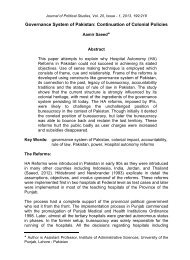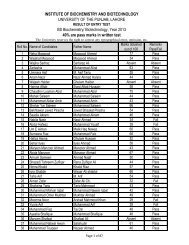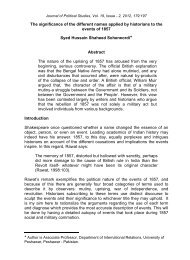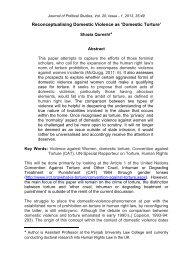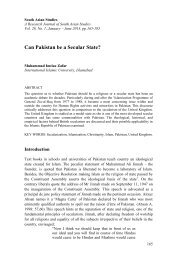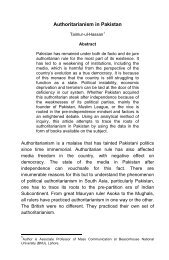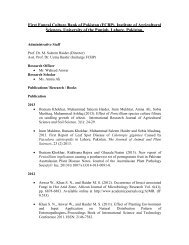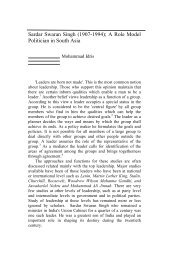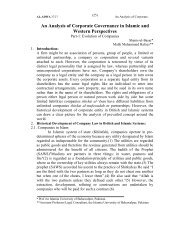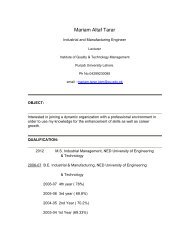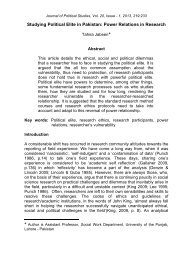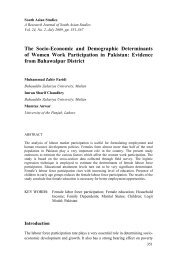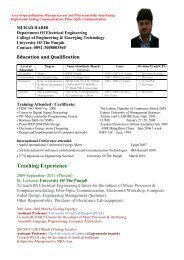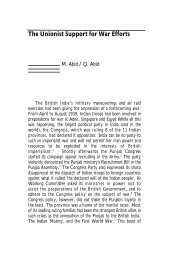pakistan geographical review 1954 - University of the Punjab
pakistan geographical review 1954 - University of the Punjab
pakistan geographical review 1954 - University of the Punjab
Create successful ePaper yourself
Turn your PDF publications into a flip-book with our unique Google optimized e-Paper software.
Tex<strong>the</strong>l<br />
Textiles may be called <strong>the</strong> most ancient industry in <strong>the</strong> Middle East.<br />
The comparatively important position <strong>of</strong> textiles is due to two reasons; firstly<br />
availability <strong>of</strong> raw materials and scondly a large home market. At present a<br />
large number <strong>of</strong> mills are engaged in ginning and spinning processes. Weaving<br />
is hindered by lack <strong>of</strong> machinery and technical skill. Under present economic<br />
development schemes textiles are being given due attention.<br />
Turkey has made a judicious use <strong>of</strong> available resources. At present<br />
<strong>the</strong>re is no need for fur<strong>the</strong>r expansion, except in production <strong>of</strong> low priced<br />
staple and basic materials. There are 12 cotton mille five state owned; 11<br />
woolen mills, 5 state owned; and two silk mills. Private mills are confined to<br />
cotton growing areas e.g, Izmir, Adana Tarsus, Mersin and Istambul. State<br />
owned factories are situated far<strong>the</strong>r inland ~at Kayseri, N azilli, Eregli Malatya<br />
and Bakirkoy. Bursa, Izmir and Istambul are <strong>the</strong> chief wollen manufacturing<br />
centres. Bursa is also noted for mohair and silk weaving. Small silk factories<br />
are also found at Istambul and Izmir. Total production is 241,758,241 yards<br />
<strong>of</strong> cotton cloth and 7,692,307 yards <strong>of</strong> woollen. It is enough to meet <strong>the</strong> local<br />
demand except in big cities where cloth <strong>of</strong> high value is to be imported.<br />
Ano<strong>the</strong>r country approaching self sufficiency is Egypt, though substantial<br />
quantities <strong>of</strong> yarn and thread are still imported comprising 20% <strong>of</strong><br />
total imports <strong>of</strong> <strong>the</strong> country. Cotton goods are specially fine textured. Before<br />
<strong>the</strong> Second World War Egygt took to silk and rayon weaving, War resulted<br />
in <strong>the</strong> closing <strong>of</strong> <strong>the</strong> Mediterranean and supplies <strong>of</strong> silk and rayon were stopped.<br />
This put an end to <strong>the</strong> wave <strong>of</strong> prosperity. Factories returned to fine cotton<br />
goods. Imports were renewed in 1945, and a revival took place in ] 946. Total<br />
output is 400 tons against a capacity at 2,000 to ns. Flax is grown within <strong>the</strong><br />
country, consequently linen thread and cloth are home products. A maxture <strong>of</strong><br />
cotton and linen is also produced. In 1953. a jute mill was erected, designed to<br />
produce 3,000 tons <strong>of</strong> hessian and sackings per year. In 1946-47 supplies <strong>of</strong><br />
jute ran short. It is now working to its full capacity but is chiefly engaged in<br />
manufacturing simple articles like ropes, twines etc. A small quantity <strong>of</strong> sisal<br />
is also used. Woollen goods are manufactured on a considerable scale but <strong>the</strong><br />
inferior quality <strong>of</strong> Egyptian wool is a handicap -,<br />
Iranian textiles mean 70% <strong>of</strong> spinning work and only 30% weaving. In<br />
1925, <strong>the</strong> state decided to supply' electric power to important areas with large<br />
scale cottage industries, so that a changeinto factory industry may be possible.<br />
4-0,



